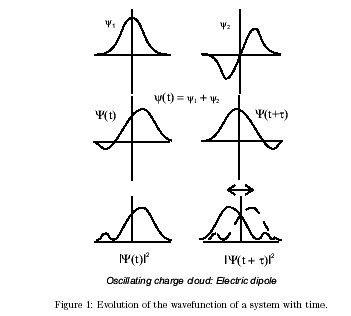
Summer 2010 Questions and Resources
Consider the transition from the 2P orbital to the 1s orbital in Hydrogen.
There are two wavefunctions here, psi1 and psi2. These wave functions are stationary in time.
However during the transition we get the sum of two wave functions and the sum varies in time, creating an oscillating charge which is a dipole electric radiator.
Here is an illustration to show this.

The probability of finding an electron is proportional to psi squared.
Great physics apps in particular ripple tank apps are available by searching for falstad
Here are the notes from anAudacity Handout
Don Rathjen activities http://www.exo.net/~donr/activities/
Paper Tape Timer reference, mathematics: http://www.exo.net/~donr/activities/Paper_Tape_Motion_Timer.pdf
Fan Cart http://www.exo.net/~donr/activities/Fan_Cart.pdf
The Internet archive keeps copies of older versions of websites. And books, movies and music all free.(If your favorite website has disappeared find it again on the archive)
Enter the name of a website to see its history.
for movies try out frames of reference http://www.archive.org/details/frames_of_reference
Light lecture powerpoint. light powerpoint
Three little pigments http://www.exploratorium.edu/snacks/cymk/
Circular keyboard http://www.exploratorium.edu:80/exhibits/highest_note/
and my lesson http://isaac.exploratorium.edu/~pauld/CILS/cilsfindthehighestnote.html
Color mixing http://www.exploratorium.edu/exhibits/mix_n_match/index.html
Mass vs radius for everything in the universe
http://www.exo.net/~pauld/physics/MR%20diagram/MRdiagram.html
Cow Eye Disection
http://www.exploratorium.edu/learning_studio/cow_eye/
Electronic versions of Summer Shop Projects
http://www.exploratorium.edu/ti/alumni/shop.html
Distortion of spacetime by mass (gravity) is described here:
http://www.exo.net/~pauld/activities/astronomy/curvedspace.html
My article in the magazine of Fantasy and Science Fiction are here:
http://www.sfsite.com/fsf/dpatmurphypauldoherty.htm
Here is the article "General Relativity at Home" http://www.sfsite.com/fsf/2000/pmpd0005.htm
And here is the article about "Bicycling at the speed of light" http://www.sfsite.com/fsf/1999/pmpd9912.htm
Here is the image of the big bang

An image of the big bang with temperature coded by color red = warm blue = cold.( the range of temperatures is 200 microdegrees Kelvin)
Here is the angular frequency spectrum of the temperature variations.
http://ca.wikipedia.org/wiki/Fitxer:WMAP_power_spectrum.jpg
This was taken by the Wilkinson Macrowave anisotropy project.
We have a Teacher Institute Facebook page. Search Facebook for Exploratorium Teacher Institute.
Geoff Gould has posted images of class on this website.
http://gallery.me.com/ggould#100469
Here are some light activities
Peel a CD, cut the aluminizing off a compact disk to make a transmssion diffraction grating.
Color Diffraction Grating, use a diffraction grating to observe the spectra of colors.
Image on a Mirror make an image on the surface of a mirror.
Fresnel lens and Laser trace laser paths through a lens.
Scan a Laser through a lens scan a lser across a lens.
Laser CD, reflect a laser off a CD to measure the line spacing of the
Laser Light, Explore the properties of laser light.
Laser Milk, Laser light scattered through milk produces a 3-d time varying interference pattern
Light Box, build a simple box to explore image making
Poisson Spot, make one with a pointer laser and a BB
Ray Tracing, How to do it
Audacity is a free sound recording program with spectrum analysis and automatic musical note identification.
San Francisco 1906 earthquake movie http://earthquake.usgs.gov/regional/nca/1906/simulations/classroom.php
Seeing Yellow (Disagreeing about color) the Snack pdf format an article by Gorazd Planinsic.
The spectra of the elements
http://ioannis.virtualcomposer2000.com/spectroscope/elements.html#elements
Air resistance force calculation. Why is air friction proportional to v^2 for turbulent airflow.
Information about human senses:
Howard Hughes Medical Institute, Seeing Hearing and Smelling the world.
A great source of physics information
Hyper Physics http://hyperphysics.phy-astr.gsu.edu/hbase/hframe.html
A source of physics data. Wolfram Alpha http://www67.wolframalpha.com/
Perception Videos
Men carrying a door between two people videos:
http://viscog.beckman.uiuc.edu/flashmovie/12.php
http://viscog.beckman.uiuc.edu/flashmovie/10.php
Gorilla:
http://viscog.beckman.uiuc.edu/grafs/demos/15.html
Others:
http://viscog.beckman.uiuc.edu/djs_lab/demos.html
Find the Highest Note
http://www.exploratorium.edu/exhibits/highest_note/ex.about.fr.html
Laser Speckle explanation
http://www.exo.net/~pauld/summer_institute/summer_day1perception/laserspeckleperception.htm
We purchase our colored filters from Holtz-Muller theater supply in San Francisco, #415-826-8383
They are $6.50 per sheet, 20 x 24 inches
TI uses Roscolux Medium Red #27
Roscolux #80 Primary Blue, and
Lee Filters #139 Primary Green.
Mix and Match
Add R G B to make other colors
http://www.exploratorium.edu/exhibits/mix_n_match/
Phosphorescent Vinyl
From educational innovations
http://www.teachersource.com/Chemistry/GlowintheDark/PhosphorescentVinylSheet.aspx
Difraction grating
From Project Star
http://www.starlab.com/psprod.html#Anchor-Holographic-35882
Air resistance F = kv vs cv^2
For laminar flow the force from air resistance is proportional to the velocity.
For turbulent flow it is proportional to velocity squared.
A bicyclist travelling at velocity v in still air experiences air friction that increases as the velocity of the bicyclist squared. F = cv^2
Let's do a simpler problem first the bicyclist colldes with a beanbag of mass m. As viewed by the bicyclist the beanbag is mving towards them and has kinetic energy E = 0.5mv^2 which goes to 0 in the inelastic collision with the byciclist. So in the inelastic collision between beanbag and bicyclist the bicyclist must do work on the beanbag to bring it to rest. The work done will be 0.5mv^2. Work is force times distance. So the force of hitting one beanbag depends on the distance over which the beanbag is brought to rest. 0.5mv^2 = F d.
Now consider a beanbag every metre, d = 1m. And calculate an average force by assuming it takes the full meter to stop the beanbag.
F = E/d = 0.5 mv^2 = Fd so F = 0.5mv^2/d
Consider air of density p moving at velocity v colliding with an object with a front surface area A.
The air comes to rest when it strikes the object. The mass of air is pV where V is the volume of air that hits the cyclist.
So the kinetic energy, E,of the air is 0.5mv^2 = 0.5 pVv^2 now the volume of air is Ad so we get
E = 0.5pAdv^2
and F = E/d = 0.5 pAv^2
the air resistance force is proportional to the density of the air, the area of the bicyclist and the velocity of the bicyclist squared.
Scientific Explorations with Paul Doherty |
21 June 2010 |